Framework for a Comprehensive Index meant to Assess the Decentralization of Social Media Platforms/Protocols
hive-167922·@lordbutterfly·
0.000 HBDFramework for a Comprehensive Index meant to Assess the Decentralization of Social Media Platforms/Protocols
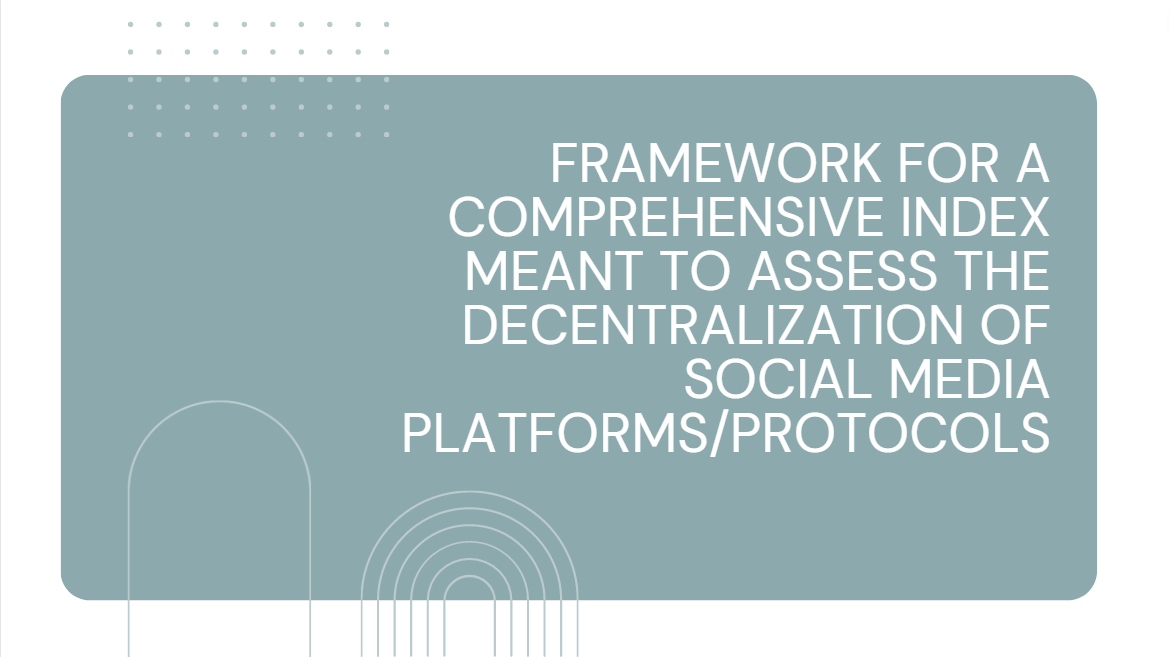 **INTRO:** This paper was written as a response to the many lies and misrepresentations present in the crypto ecosystem where uninformed users and investors are trapped by project owners lying about the attributes of their projects. *This was inspired by @scottcbusiness decentralization matrix made a few years ago.* Decentralization being one of those attributes. I saw @jongolson ping me today in a post discussing the topic of Coingecko posting that absurd and laughable graphic on Twitter so I said to myself: >Why not make a tool that might help determine a level of decentralization of certain projects. So here it is. *As a note... I wrote this in 4 hours. To write a framework for an Index on par with what you see in research papers would take many more hours of research and work. This is just a basis from which we can go forward and expand. Ill be taking payments in hugs and kisses to finish this.* 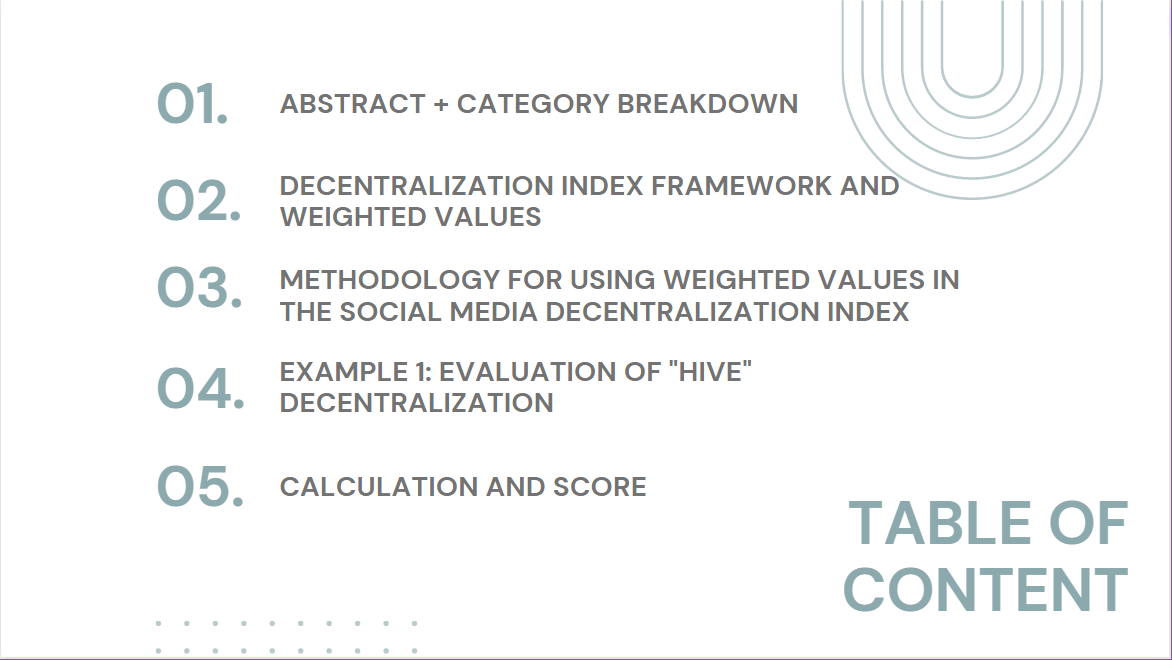 ### **Abstract** This paper presents a framework for a comprehensive index designed to evaluate the decentralization levels of social media platforms in the blockchain/crypto ecosystem with the intent of offering investors and users a clear understanding of WEB3 aligned platforms by addressing the underlying attributes of each of them in a space where certain platforms are known to misrepresent the features of their projects. This method will be presented publicly, will be repeatable and reproducible. Decentralization in this context encompasses various categories, **including governance structure, data ownership, content moderation policies, censorship resistance, open-source development, node distribution, token/wealth distribution, and transacting capabilities.** The index comprises multiple indicators for each category, quantifying different dimensions of decentralization. Weighted scores are calculated based on these indicators, providing a holistic assessment of decentralization for individual platforms. My hope is that the index will serve as a valuable tool for investors, policymakers, and users interested in understanding and comparing the decentralization features of various social media platforms. ### **CATEGORY BREAKDOWN AND EXPLANATION:** **Category 1: Governance Structure** This category focuses on the decision-making process and transparency in governance decisions. Indicator 1 evaluates the presence of a distributed decision-making process, which refers to whether decision making power is decentralized among multiple stakeholders. Indicator 2 measures the transparency of governance decisions, indicating the extent to which the platform provides clear, frequent and accessible information about its governance processes and decision-making. **Category 2: Data Ownership** This category examines the level of ownership and control that users have over their accounts and the security measures implemented by the platform in regards to account ownership. Indicator 1 assesses the extent to which users has control over their accounts while considering the power the platform has over user account deletion. Can the platform affect user account ownership in any way? Indicator 2 evaluates the security measures implemented by the platform to protect user accounts from unauthorized access and breaches. **Category 3: Content Moderation Policies** This category focuses on the platform's content moderation policies, considering the involvement of the community and the transparency and clarity of moderation guidelines. Indicator 1 examines whether the platform employs community moderation, enabling users to participate in content moderation processes. Indicator 2 evaluates the transparency of moderation guidelines, indicating the clarity and accessibility of the platform's guidelines for content moderation. **Category 4: Censorship Resistance and Free Speech** This category evaluates the platform's resistance to government-imposed censorship and the potential for censorship or removal by the platform itself. Indicator 1 assesses the platform's resilience against government-imposed censorship, taking into account measures to protect user-generated content from external censorship. Indicator 2 examines whether the platform has the authority to censor, ban, or remove users or content, potentially impacting freedom of speech and expression. **Category 5: Open-Source Development** This category assesses the extent to which the platform embraces open-source principles, community involvement in development, and the availability and quality of development resources and documentation. Indicator 1 examines whether the platform utilizes open-source software. Indicator 2 evaluates the level of community involvement in the platform's development processes. Indicator 3 assesses the availability of development resources and documentation, and ease of access to them which facilitates community participation and innovation. **Category 6: Node Distribution** This category focuses on the distribution and diversity of nodes in the platform's network, as well as incentives for running nodes. Indicator 1 assesses the number of independent nodes in the platform's network, indicating the degree of decentralization. Indicator 2 evaluates the geographic diversity of nodes, considering their distribution across different regions. Indicator 3 examines the presence of incentives, such as rewards to encourage users to run nodes and contribute to network stability. **Category 7: Token/Wealth Distribution** This category evaluates the distribution of tokens or wealth among stakeholders and non-staked holders within the platform's ecosystem and the mechanisms in place to address wealth inequality. It also asses if there was an ICO and a distribution towards the team/dev structure with indicator 1. Indicator 2 assesses the distribution of tokens, considering factors such as token allocations and wealth concentration. Indicator 3 evaluates the presence of mechanisms within the platform to address wealth inequality, such as token redistribution and contribution incentives via a DAO, or else. **Category 8: Transacting** This category focuses on the platforms support for seamless and interference free transactions. Indicator 1 assesses the ability to transact freely without platform interference, indicating whether the platform imposes restrictions or limitations on user transactions. Indicator 2 evaluates the level of liquidity availability for the specific token which is intended to show ability to easily exchange in and out of the system. Higher scores assigned to token listings on top 10 centralized exchanges and based on trading pair liquidity on DEXes. ### DECENTRALIZATION INDEX FRAMEWORK AND WEIGHTED VALUES 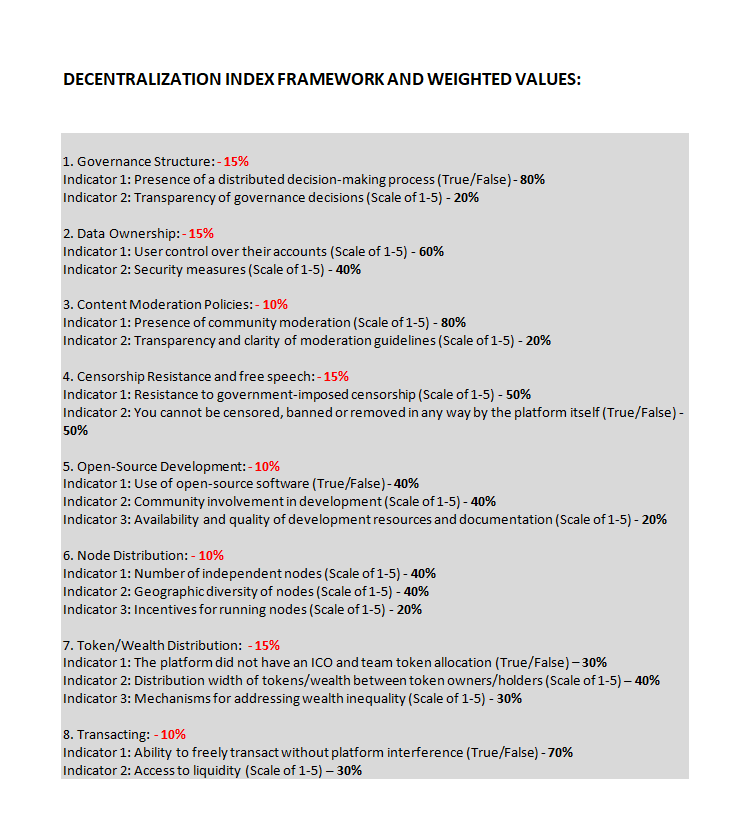 <center>*In text form below*</center> **1. Governance Structure: - 15%** Indicator 1: Presence of a distributed decision-making process (True/False) - 80% Indicator 2: Transparency of governance decisions (Scale of 1-5) - 20% **2. Data Ownership: - 15%** Indicator 1: User control over their accounts (Scale of 1-5) - 60% Indicator 2: Security measures (Scale of 1-5) - 40% **3. Content Moderation Policies: - 10%** Indicator 1: Presence of community moderation (Scale of 1-5) - 80% Indicator 2: Transparency and clarity of moderation guidelines (Scale of 1-5) - 20% **4. Censorship Resistance and free speech: - 15%** Indicator 1: Resistance to government-imposed censorship (Scale of 1-5) - 50% Indicator 2: You cannot be censored, banned or removed in any way by the platform itself (True/False) - 50% **5. Open-Source Development: - 10%** Indicator 1: Use of open-source software (True/False) - 40% Indicator 2: Community involvement in development (Scale of 1-5) - 40% Indicator 3: Availability and quality of development resources and documentation (Scale of 1-5) - 20% **6. Node Distribution: - 10%** Indicator 1: Number of independent nodes (Scale of 1-5) - 40% Indicator 2: Geographic diversity of nodes (Scale of 1-5) - 40% Indicator 3: Incentives for running nodes (Scale of 1-5) - 20% **7. Token/Wealth Distribution: - 15%** Indicator 1: The platform did not have an ICO and team token allocation (True/False) – 30% Indicator 2: Distribution width of tokens/wealth between token owners/holders (Scale of 1-5) – 40% Indicator 3: Mechanisms for addressing wealth inequality (Scale of 1-5) - 30% **8. Transacting: - 10%** Indicator 1: Ability to freely transact without platform interference (True/False) - 70% Indicator 2: Access to liquidity (Scale of 1-5) – 30% ### Methodology for Using Weighted Values in the Social Media Decentralization Index: 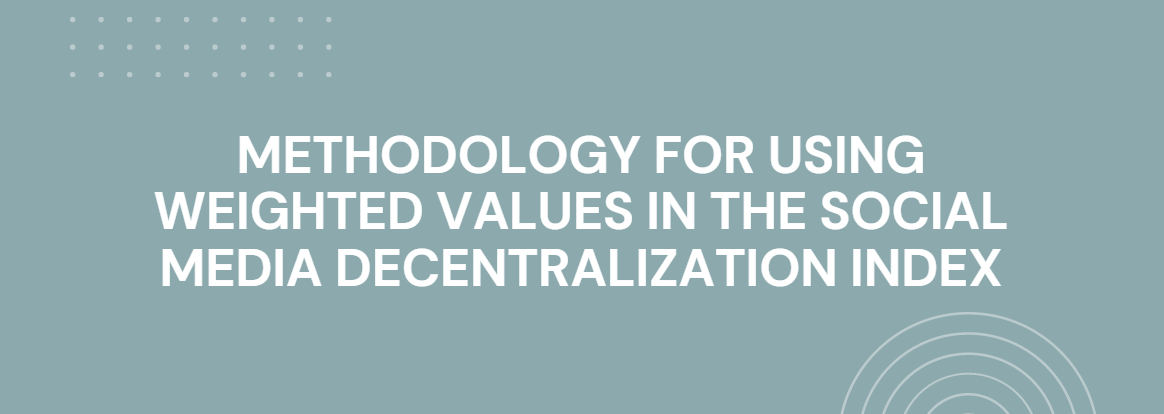 The Social Media Decentralization Index incorporates weighted values to assign importance to different categories and indicators in assessing the decentralization of social media platforms. The methodology involves the following steps: 1. a) Category definition: The index consists of eight categories that capture various aspects of decentralization in social media platforms. These categories were carefully chosen to encompass key dimensions such as governance structure, data ownership, content moderation, censorship resistance, open-source development, node distribution, token/wealth distribution, and transacting capabilities. b) Indicator Definition: Within each category, specific indicators were defined to quantify and evaluate relevant factors. Each indicator focuses on a particular aspect of the category, providing measurable criteria for assessment. 2. a) Category scoring: Weights were assigned to each category to reflect their relative importance in assessing decentralization. These weights represent the proportionate contribution of each category to the overall index. The weights were determined based on careful consideration while taking into account the significance of each category in determining decentralization. b) Indicator Scoring: For each indicator, a specific scoring method was defined. This could involve binary (True/False) = (0 or 5) responses, rating scales, or a combination of both. Scoring criteria were designed to capture the varying degrees or qualities of decentralization. 3. a) Calculation of Weighted Scores: Weighted scores for each indicator were calculated by multiplying the indicator's raw score by the weight assigned to its respective category. These weighted scores reflect the contribution of each indicator to its corresponding category and, in turn, to the overall index. b) Overall Index Calculation: The overall index score for a social media platform was obtained by summing up the weighted scores across all categories and indicators. This cumulative score provides a comprehensive measure of the platform's decentralization level, considering the combined impact of all evaluated factors. *By utilizing the weighted values and methodology described above, the Social Media Decentralization Index enables a systematic and standardized evaluation of social media platforms, facilitating comparisons and insights into their decentralization characteristics.* ### EXAMPLE 1: HIVE **Evaluation of Hive's Decentralization Using the Social Media Decentralization framework** 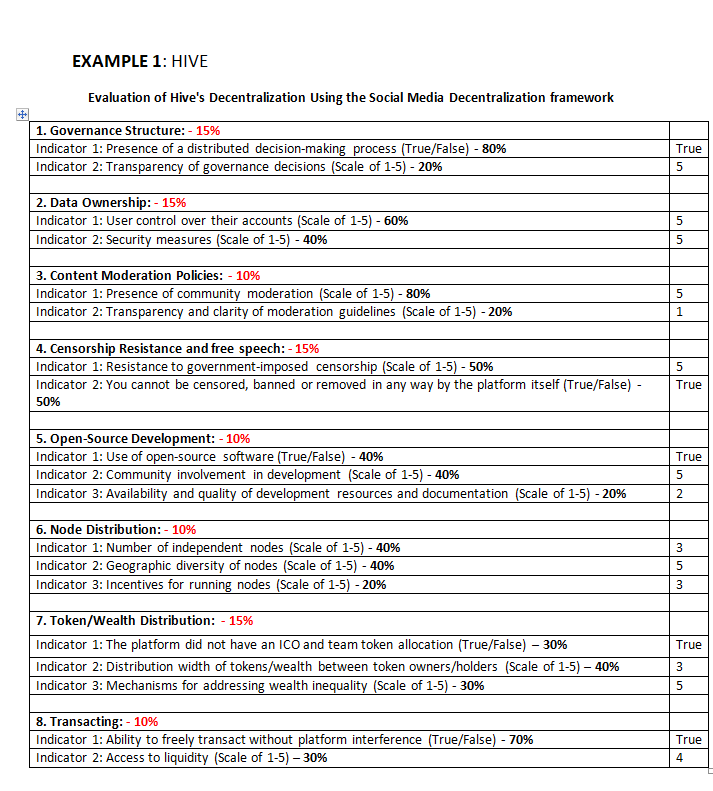 <center> *In text form belo*w </center> 1. Governance Structure: - 15% Indicator 1: Presence of a distributed decision-making process (True/False) - 80% True Indicator 2: Transparency of governance decisions (Scale of 1-5) - 20% 5 2. Data Ownership: - 15% Indicator 1: User control over their accounts (Scale of 1-5) - 60% 5 Indicator 2: Security measures (Scale of 1-5) - 40% 5 3. Content Moderation Policies: - 10% Indicator 1: Presence of community moderation (Scale of 1-5) - 80% 5 Indicator 2: Transparency and clarity of moderation guidelines (Scale of 1-5) - 20% 1 4. Censorship Resistance and free speech: - 15% Indicator 1: Resistance to government-imposed censorship (Scale of 1-5) - 50% 5 Indicator 2: You cannot be censored, banned or removed in any way by the platform itself (True/False) - 50% True 5. Open-Source Development: - 10% Indicator 1: Use of open-source software (True/False) - 40% True Indicator 2: Community involvement in development (Scale of 1-5) - 40% 5 Indicator 3: Availability and quality of development resources and documentation (Scale of 1-5) - 20% 2 6. Node Distribution: - 10% Indicator 1: Number of independent nodes (Scale of 1-5) - 40% 3 Indicator 2: Geographic diversity of nodes (Scale of 1-5) - 40% 5 Indicator 3: Incentives for running nodes (Scale of 1-5) - 20% 3 7. Token/Wealth Distribution: - 15% Indicator 1: The platform did not have an ICO and team token allocation (True/False) – 30% True Indicator 2: Distribution width of tokens/wealth between token owners/holders (Scale of 1-5) – 40% 3 Indicator 3: Mechanisms for addressing wealth inequality (Scale of 1-5) - 30% 5 8. Transacting: - 10% Indicator 1: Ability to freely transact without platform interference (True/False) - 70% True Indicator 2: Access to liquidity (Scale of 1-5) – 30% 4 ### CALCULATION: Governance Structure: Indicator 1 = 5 (True) Indicator 2 = 5 Category Score: (5 * 0.8) + (5 * 0.2) = 5 Data Ownership: Indicator 1 = 5 Indicator 2 = 5 Category Score: (5 * 0.5) + (5 * 0.5) = 5 Content Moderation Policies: Indicator 1 = 5 Indicator 2 = 1 Category Score: (5 * 0.8) + (1 * 0.2) = 4.2 Censorship Resistance and free speech: Indicator 1 = 5 Indicator 2 = 5 (True) Category Score: (5 * 0.5) + (5 * 0.5) = 5 Open-Source Development: Indicator 1 = 5 (True) Indicator 2 = 5 Indicator 3 = 2 Category Score: (5 * 0.4) + (5 * 0.4) + (2 * 0.2) = 4.4 Node Distribution: Indicator 1 = 3 Indicator 2 = 5 Indicator 3 = 3 Category Score: (3 * 0.4) + (5 * 0.4) + (3 * 0.2) = 3.8 Token/Wealth Distribution: Indicator 1 = 5 (True) Indicator 2 = 3 Indicator 3 = 5 Category Score: (5 * 0.3) + (3 * 0.4) + (5 * 0.3) = 4.2 Transacting: Indicator 1 = 5 (True) Indicator 2 = 4 Category Score: (5 * 0.7) + (4 * 0.3) = 4.7 TOTAL: (5x0.15) +(5x0.15) +( 4.2x0.1) + (5x0.15) + (4.4x0.1) + (3.8x0.1) + (4.2x0.15) + (4.7x0.1)= 4.59 ## HIVE SCORE: 91.8% (4.59/5) PS: Missing a developed methodology on determining the range on the scale 1-5 for various indicators. Once platforms are input and compared, benchmark values can be set for, ex. “Liquidity access”,” token distribution”, etc. Once more results are presented thresholds for decentralization can be determined. **OUTRO:** For each of the platforms assessed using this framework, a breakdown of each indicator and category would have to be made, as is the case with Hive here in the example. I obviously did not do that as this post would be double the size. My goal was to show that an Index accurately quantifying the decentralization level in crypto social media platforms/protocols is possible and should be created as a way to protect investors and users themselves. *First step, make some nice looking graphics out of this. Everyones making indexes, we can as well. At least I think this one makes sense.*
👍 joeyarnoldvn, bpcvoter, netaterra, moneymisstress, therealyme, thaddeusprime, growandbow, franciscopr, sshappydayz, uche-nna, babytarazkp, drricksanchez, drexlord, smartvote, diggndeeper.com, william-gregory, coolguy123, stoodkev, cedricguillas, stoodmonsters, mimi.ruby, silentscreamer, andyblack, penderis, newhope, freebornsociety, bilpcoinrecords, laruche, marco77290, cocaaladioxine, walterjay, aidefr, sorin.cristescu, robotics101, orlandumike, pboulet, kggymlife, louis00334, nopasaran72, urtrailer, hoffmeister84, w-splatts, gone-hive, jlsplatts, lunaticpandora, foodfightfriday, kuku-splatts, splatts, vortac, greencross, weirdheadaches, paulmoon410, krommus, cryptosharon, sgbonus, grider123, lukecreed, ultrablackhole, yacobh, smokingfit, mryoung1979, solarwarrior, apineda, nazaleo, lordbutterfly, cyclope, agustinaka, catinthewindow, jhelbich, fatman, voter002, eturnerx-dbuzz, pepitagold, francosteemvotes, lpv, phoneinf, kurkumita, skiptvads, shaka, sportsgeek, musicgeek, marketinggeek, coinomite, penguinpablo, cryptonized, hive.friends, funnyman, alphacore, hungrybear, jacuzzi, moserich, joseda94, idig, abrahan414, wanker, bings-cards, bingbabe, dismayedworld, fabulousfurlough, slobberchops, trillemille, imcore, jaouad2d, mawit07, logicforce, cubapl, plusvault, patronpass, cute-cactus, aliakbar2, technico, cconn, tomwafula, minerspost, darkpylon, themonetaryfew, hjrrodriguez, bil.prag, uwelang, currentxchange, leprechaun, rocksg, daltono, the13anarchist, bluerobo, blue-witness, pibara, yaroschain, tomhall.leo, albro, khinghetz, trumpman, ruth-girl, belemo, giotists, joshman, belemo.leo, penned-bullshit, pappyelblanco, jaraumoses, tesaganewton, ph1102, cryptofiloz, rcaine, ssekulji, edkarnie, wealthwess, kevmcc, new-world-steem, acidyo, steeminator3000, gniksivart, tobias-g, ghaazi, rendrianarma, hyun-soo, worldwildflora, xves, mister-meeseeks, bigmoneyman, zhoten, leveluplifestyle, trasto, tillmea, mdasein, ninnu, rmach, elyelma, freedomring, scottcbusiness, meltysquid, vlemon, ausbitbank, shanibeer, poshtoken, nomnomnomnom, jkramer, jphamer1, ybanezkim26, jk6276, juanvegetarian, mrnightmare89, enforcer48, steemseph, adamada, jude.villarta, jazzhero, tsnaks, m2nnari, steemitmonsters, sydechan, breelikeatree, surrealis, dudeontheweb, dstampede, awuahbenjamin, starbork, pardinus, sofs-su, bulkathos, whatsup, trafalgar, raindrop, traf, julesquirin, xtrafalgar, springlining, manniman, el-dee-are-es, fitnessgourmet, marvinman, wiseagent, politeumico, dalz, piotrgrafik, olaunlimited, nonameslefttouse, timcliff, wend1go, affliction, borran, thrasher666, fredrikaa, hivesuperman, gledys19, fizz0, demon19, kedi, photographercr, erikkartmen, thespacebetween, rubido, brianoflondon, hivehydra, podping, cryptoccshow, jdike, softworld, ksjegw, santigs, tipu, kingscrown, kryptogames, bcm, dappstats, xtipu, boatymcboatface, theshell, cryptogambit, bartheek, atongis, peniel2010, longer, michelledina, deepresearch, cryptomaniacsgr, melcaya, louis88, yaros.rudy, lion-bull, oflyhigh, wherein, lnakuma, hive-108278, celeste413, cnstm, likuang007, lianjingmedia, zerofive, starrouge, wrestlingdesires, vyb.curation, dwinblood, richardcrill, nonsowrites, dalz.shorts, flamistan, khoola, trostparadox.vyb, crazygirl777, steemexperience, vyb.pob, topbooster, coffeebuds, proofofbrainio, saboin.pob, vyb.fund, trangbaby, babeltrips, dodovietnam, phuongthao98, thaolaven, thu172, lynnnguyen, kimloan, winnietran, dora381, whynotcamp, crazy-bee, sunnyvo, hyhy93, lamphuong, ivypham, danghao, youdontknowme, diehardknocks, a-quarius, fortune-master, passion-fruit, traciyork, ikrahch, ndk.focus, fw206, trostparadox, davidbright, patsitivity, xyba, rbalzan79, brutus22, titusfrost, abu78, watchlist, forykw, forkyishere, allentaylor, vaipraonde, riansilva, teammo, simplegame, bilpcoin.pay, vasko90, anttn, unity-freedom, anttn.support, leosoph, theycallmedan, xtheycallmedan, arabisouri, ahmedsy, thegoliath, cmplxty.leo, depressed.leo, katerinaramm, aboutheraklion, schindmaehre, fotomaglys, jaybone, jayrent, ardina,